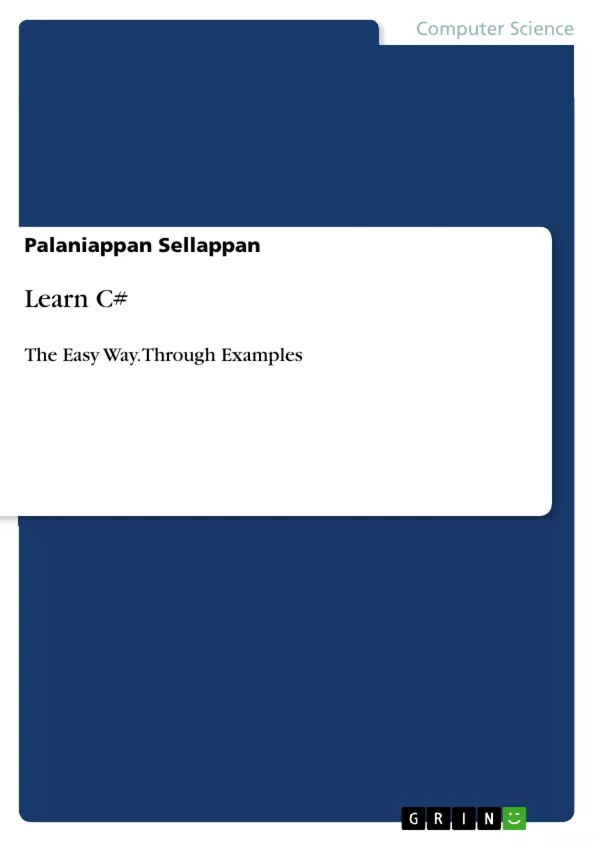Visual C# 2015, one of the components of Visual Studio 2015, is one of the most powerful, versatile and modern object-oriented programming languages available today. Developed by Microsoft, it combines all the best features available in programming languages.
C# provides a rich repertoire of library/built-in functions that allow programmers to develop all kinds of applications with relative ease - be it Console, Windows/Forms, Web or Mobile Applications.
This book is intended for beginners as well as those with some programming knowledge. It is suitable for those students who are pursuing a course in Computer Science, Software Engineering, Information Technology, Management Information Systems, Engineering and Mathematics. It starts with the basics, and gradually progresses to more advanced topics such as arrays, structures, classes, text files and databases. So whether you are a beginner or intermediate programmer, this book will help you master the essentials of C# very quickly. The book is written in a simple, easy-to-read style and contains numerous examples to illustrate the concepts presented. It also contains exercises at the end of each chapter to test your grasp of the subject matter.
Table of Contents
- Chapter 1
- Introducing C#...
- Visual C#.NET.
- Visual Studio.NET.
- The .NET Framework..
- System Requirements..
- Visual Studio.NET IDE.
- Console Application....
- Windows/Forms Application....
- Editing, Compiling & Executing C# Programs….
- Parts of A C# Program..
- Exercise......
- Chapter 2
- Object-Oriented Concepts..
- Classes & Objects....
- Object Interaction.
- Class Hierarchy & Inheritance..
- Accessibility of Class Members..
- Polymorphism..
- Interfaces.....
- Coding for Objects..
- Exercise....
- Chapter 3
- C# Basics...
- Data Types...
- Identifiers..
- Variables, Constants, and Literals.
- Declaring Variables and Constants.
- Operators and Expressions....
- Assignment Statements..
- Type Casting & Boxing/Unboxing..
- Checking and Unchecking..
- Input/Output Statements..
- Namespaces..
- Exercise.....
- Chapter 4
- Program Control Structures...
- Controlling Program Execution..
- Sequence Structure..
- Selection Structure...
- Loop/Repetition Structure..
- Other Branching Commands.
- Infinite Loops...
- Exercise...
- Chapter 5
- Built-in Methods...
- Built-in Methods.
Objectives and Key Themes
This book aims to introduce both beginners and those with some programming experience to the fundamentals of C#. It covers a wide range of topics, starting with basic concepts and progressively moving towards more advanced topics such as arrays, structures, classes, text files, and databases. The objective is to help readers master the essential concepts of C# and equip them with the knowledge to develop various applications.
- Fundamentals of C# programming
- Object-oriented programming concepts and implementation
- Control flow structures and methods
- Working with data structures, classes, and files
- Building console, Windows, web, and mobile applications
Chapter Summaries
Chapter 1 introduces the C# programming language, the Visual Studio environment, and the .NET framework. It also covers the basics of creating and running simple console and Windows/Forms applications.
Chapter 2 explores fundamental object-oriented programming concepts such as classes, objects, inheritance, polymorphism, and interfaces. It delves into the principles of object interaction and the use of constructors and destructors.
Chapter 3 focuses on the core concepts of C# programming, including data types, variables, constants, operators, expressions, and namespaces. It also covers type casting, boxing, unboxing, and input/output operations.
Chapter 4 explores various program control structures, including sequence, selection, and repetition structures. It provides insights into controlling program execution using conditional statements, loops, and branching commands.
Chapter 5 introduces various built-in methods available in C# that can be utilized to perform common programming tasks efficiently.
Keywords
C#, object-oriented programming, .NET framework, Visual Studio, data types, variables, operators, control flow, methods, classes, objects, inheritance, polymorphism, interfaces, arrays, structures, files, databases, console applications, Windows/Forms applications.
- Quote paper
- Prof. Dr. Palaniappan Sellappan (Author), 2018, Learn C#, Munich, GRIN Verlag, https://www.grin.com/document/435400



